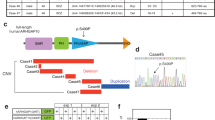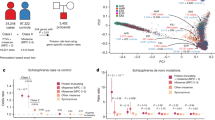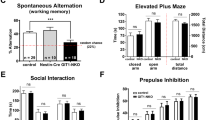Abstract
Although the pathogenesis of schizophrenia (SCZ) is proposed to involve alterations of neural circuits via synaptic dysfunction, the underlying molecular mechanisms remain poorly understood. Recent exome sequencing studies of SCZ have uncovered numerous single-nucleotide variants (SNVs); however, the majority of these SNVs have unknown functional consequences, leaving their disease relevance uncertain. Filling this knowledge gap requires systematic application of quantitative and scalable assays to assess known and novel biological functions of genes. Here we demonstrate loss-of-function effects of multiple rare coding SNVs found in SCZ subjects in the GIT1 (G protein-coupled receptor kinase interacting ArfGAP 1) gene using functional cell-based assays involving coexpression of GIT1 and PAK3 (p21 protein (Cdc42/Rac)-activated kinase 3). Most notably, a GIT1-R283W variant reported in four independent SCZ cases was defective in activating PAK3 as well as MAPK (mitogen-activated protein kinase). Similar functional deficits were found for a de novo SCZ variant GIT1-S601N. Additional assays revealed deficits in the capacity of GIT1-R283W to stimulate PAK phosphorylation in cultured hippocampal neurons. In addition, GIT1-R283W showed deficits in the induction of GAD1 (glutamate decarboxylase 1) protein expression. Extending these functional assays to 10 additional rare GIT1 variants revealed the existence of an allelic series with the majority of the SCZ case variants exhibiting loss of function toward MAPK activation in a manner correlated with loss of PAK3 activation. Taken together, we propose that rare variants in GIT1, along with other genetic and environmental factors, cause dysregulation of PAK3 leading to synaptic deficits in SCZ.
This is a preview of subscription content, access via your institution
Access options
Subscribe to this journal
Receive 12 print issues and online access
$259.00 per year
only $21.58 per issue
Buy this article
- Purchase on Springer Link
- Instant access to full article PDF
Prices may be subject to local taxes which are calculated during checkout





Similar content being viewed by others
References
Sullivan PF, Kendler KS, Neale MC . Schizophrenia as a complex trait: evidence from a meta-analysis of twin studies. Arch Gen Psychiatry 2003; 60: 1187–1192.
Schizophrenia Psychiatric Genome-Wide Association Study (GWAS) Consortium. Genome-wide association study identifies five new schizophrenia loci. Nat Genet 2011; 43: 969–976.
Cross-Disorder Group of the Psychiatric Genomics Consortium. Identification of risk loci with shared effects on five major psychiatric disorders: a genome-wide analysis. Lancet 2013; 381: 1371–1379.
Schizophrenia Working Group of the Psychiatric Genomics Consortium. Biological insights from 108 schizophrenia-associated genetic loci. Nature 2014; 511: 421–427.
International Schizophrenia Consortium. Rare chromosomal deletions and duplications increase risk of schizophrenia. Nature 2008; 455: 237–241.
Kirov G, Pocklington AJ, Holmans P, Ivanov D, Ikeda M, Ruderfer D et al. De novo CNV analysis implicates specific abnormalities of postsynaptic signalling complexes in the pathogenesis of schizophrenia. Mol Psychiatry 2012; 17: 142–153.
Need AC, McEvoy JP, Gennarelli M, Heinzen EL, Ge D, Maia JM et al. Exome sequencing followed by large-scale genotyping suggests a limited role for moderately rare risk factors of strong effect in schizophrenia. Am J Hum Genet 2012; 91: 303–312.
Fromer M, Pocklington AJ, Kavanagh DH, Williams HJ, Dwyer S, Gormley P et al. De novo mutations in schizophrenia implicate synaptic networks. Nature 2014; 506: 179–184.
Timms AE, Dorschner MO, Wechsler J, Choi KY, Kirkwood R, Girirajan S et al. Support for the N-methyl-D-aspartate receptor hypofunction hypothesis of schizophrenia from exome sequencing in multiplex families. JAMA Psychiatry 2013; 70: 582–590.
Purcell SM, Moran JL, Fromer M, Ruderfer D, Solovieff N, Roussos P et al. A polygenic burden of rare disruptive mutations in schizophrenia. Nature 2014; 506: 185–190.
Sullivan PF, Daly MJ, O'Donovan M . Genetic architectures of psychiatric disorders: the emerging picture and its implications. Nat Rev Genet 2012; 13: 537–551.
Darnell JC, Van Driesche SJ, Zhang C, Hung KY, Mele A, Fraser CE et al. FMRP stalls ribosomal translocation on mRNAs linked to synaptic function and autism. Cell 2011; 146: 247–261.
Schmalzigaug R, Phee H, Davidson CE, Weiss A, Premont RT . Differential expression of the ARF GAP genes GIT1 and GIT2 in mouse tissues. J Histochem Cytochem 2007; 55: 1039–1048.
Kim S, Ko J, Shin H, Lee JR, Lim C, Han JH et al. The GIT family of proteins forms multimers and associates with the presynaptic cytomatrix protein Piccolo. J Biol Chem 2003; 278: 6291–6300.
Ko J, Kim S, Valtschanoff JG, Shin H, Lee JR, Sheng M et al. Interaction between liprin-alpha and GIT1 is required for AMPA receptor targeting. J Neurosci 2003; 23: 1667–1677.
Zhang H, Webb DJ, Asmussen H, Horwitz AF . Synapse formation is regulated by the signaling adaptor GIT1. J Cell Biol 2003; 161: 131–142.
Podufall J, Tian R, Knoche E, Puchkov D, Walter AM, Rosa S et al. A presynaptic role for the cytomatrix protein GIT in synaptic vesicle recycling. Cell Rep 2014; 7: 1417–1425.
Smith KR, Davenport EC, Wei J, Li X, Pathania M, Vaccaro V et al. GIT1 and betaPIX are essential for GABA(A) receptor synaptic stability and inhibitory neurotransmission. Cell Rep 2014; 9: 298–310.
Montesinos MS, Dong W, Goff K, Das B, Guerrero-Given D, Schmalzigaug R et al. Presynaptic deletion of GIT proteins results in increased synaptic strength at a mammalian central synapse. Neuron 2015; 88: 918–925.
Zhang H, Webb DJ, Asmussen H, Niu S, Horwitz AF . A GIT1/PIX/Rac/PAK signaling module regulates spine morphogenesis and synapse formation through MLC. J Neurosci 2005; 25: 3379–3388.
Schmalzigaug R, Rodriguiz RM, Bonner PE, Davidson CE, Wetsel WC, Premont RT . Impaired fear response in mice lacking GIT1. Neurosci Lett 2009; 458: 79–83.
Menon P, Deane R, Sagare A, Lane SM, Zarcone TJ, O'Dell MR et al. Impaired spine formation and learning in GPCR kinase 2 interacting protein-1 (GIT1) knockout mice. Brain Res 2010; 1317: 218–226.
Won H, Mah W, Kim E, Kim JW, Hahm EK, Kim MH et al. GIT1 is associated with ADHD in humans and ADHD-like behaviors in mice. Nat Med 2011; 17: 566–572.
Premont RT, Claing A, Vitale N, Freeman JL, Pitcher JA, Patton WA et al. beta2-Adrenergic receptor regulation by GIT1, a G protein-coupled receptor kinase-associated ADP ribosylation factor GTPase-activating protein. Proc Natl Acad Sci USA 1998; 95: 14082–14087.
Bagrodia S, Bailey D, Lenard Z, Hart M, Guan JL, Premont RT et al. A tyrosine-phosphorylated protein that binds to an important regulatory region on the cool family of p21-activated kinase-binding proteins. J Biol Chem 1999; 274: 22393–22400.
Zhao ZS, Manser E, Loo TH, Lim L . Coupling of PAK-interacting exchange factor PIX to GIT1 promotes focal complex disassembly. Mol Cell Biol 2000; 20: 6354–6363.
Zhang ZM, Simmerman JA, Guibao CD, Zheng JJ . GIT1 paxillin-binding domain is a four-helix bundle, and it binds to both paxillin LD2 and LD4 motifs. J Biol Chem 2008; 283: 18685–18693.
Schmalzigaug R, Garron ML, Roseman JT, Xing Y, Davidson CE, Arold ST et al. GIT1 utilizes a focal adhesion targeting-homology domain to bind paxillin. Cell Signal 2007; 19: 1733–1744.
Schlenker O, Rittinger K . Structures of dimeric GIT1 and trimeric beta-PIX and implications for GIT-PIX complex assembly. J Mol Biol 2009; 386: 280–289.
Manser E, Loo TH, Koh CG, Zhao ZS, Chen XQ, Tan L et al. PAK kinases are directly coupled to the PIX family of nucleotide exchange factors. Mol Cell 1998; 1: 183–192.
Allen KM, Gleeson JG, Bagrodia S, Partington MW, MacMillan JC, Cerione RA et al. PAK3 mutation in nonsyndromic X-linked mental retardation. Nat Genet 1998; 20: 25–30.
Kutsche K, Yntema H, Brandt A, Jantke I, Nothwang HG, Orth U et al. Mutations in ARHGEF6, encoding a guanine nucleotide exchange factor for Rho GTPases, in patients with X-linked mental retardation. Nat Genet 2000; 26: 247–250.
Ramakers GJ, Wolfer D, Rosenberger G, Kuchenbecker K, Kreienkamp HJ, Prange-Kiel J et al. Dysregulation of Rho GTPases in the alphaPix/Arhgef6 mouse model of X-linked intellectual disability is paralleled by impaired structural and synaptic plasticity and cognitive deficits. Hum Mol Genet 2012; 21: 268–286.
Boda B, Alberi S, Nikonenko I, Node-Langlois R, Jourdain P, Moosmayer M et al. The mental retardation protein PAK3 contributes to synapse formation and plasticity in hippocampus. J Neurosci 2004; 24: 10816–10825.
Kreis P, Thevenot E, Rousseau V, Boda B, Muller D, Barnier JV . The p21-activated kinase 3 implicated in mental retardation regulates spine morphogenesis through a Cdc42-dependent pathway. J Biol Chem 2007; 282: 21497–21506.
Dai X, Iwasaki H, Watanabe M, Okabe S . Dlx1 transcription factor regulates dendritic growth and postsynaptic differentiation through inhibition of neuropilin-2 and PAK3 expression. Eur J Neurosci 2014; 39: 531–547.
Hayashi ML, Choi SY, Rao BS, Jung HY, Lee HK, Zhang D et al. Altered cortical synaptic morphology and impaired memory consolidation in forebrain- specific dominant-negative PAK transgenic mice. Neuron 2004; 42: 773–787.
Yin G, Haendeler J, Yan C, Berk BC . GIT1 functions as a scaffold for MEK1-extracellular signal-regulated kinase 1 and 2 activation by angiotensin II and epidermal growth factor. Mol Cell Biol 2004; 24: 875–885.
Manabe R, Kovalenko M, Webb DJ, Horwitz AR . GIT1 functions in a motile, multi-molecular signaling complex that regulates protrusive activity and cell migration. J Cell Sci 2002; 115 (Pt 7): 1497–1510.
Biasini M, Bienert S, Waterhouse A, Arnold K, Studer G, Schmidt T et al. SWISS-MODEL: modelling protein tertiary and quaternary structure using evolutionary information. Nucleic Acids Res 2014; 42 (Web Server issue): W252–W258.
Bai M, Pang X, Lou J, Zhou Q, Zhang K, Ma J et al. Mechanistic insights into regulated cargo binding by ACAP1 protein. J Biol Chem 2012; 287: 28675–28685.
Pei J, Grishin NV . PROMALS3D: multiple protein sequence alignment enhanced with evolutionary and three-dimensional structural information. Methods Mol Biol 2014; 1079: 263–271.
Lewis DA . Inhibitory neurons in human cortical circuits: substrate for cognitive dysfunction in schizophrenia. Curr Opin Neurobiol 2014; 26: 22–26.
Mo A, Mukamel EA, Davis FP, Luo C, Henry GL, Picard S et al. Epigenomic signatures of neuronal diversity in the mammalian brain. Neuron 2015; 86: 1369–1384.
Kahn RA, Bruford E, Inoue H, Logsdon JM Jr, Nie Z, Premont RT et al. Consensus nomenclature for the human ArfGAP domain-containing proteins. J Cell Biol 2008; 182: 1039–1044.
Ismail SA, Vetter IR, Sot B, Wittinghofer A . The structure of an Arf-ArfGAP complex reveals a Ca2+ regulatory mechanism. Cell 2010; 141: 812–821.
Meyer MZ, Deliot N, Chasserot-Golaz S, Premont RT, Bader MF, Vitale N . Regulation of neuroendocrine exocytosis by the ARF6 GTPase-activating protein GIT1. J Biol Chem 2006; 281: 7919–7926.
Rumbaugh G, Adams JP, Kim JH, Huganir RL . SynGAP regulates synaptic strength and mitogen-activated protein kinases in cultured neurons. Proc Natl Acad Sci USA 2006; 103: 4344–4351.
Rejeb I, Saillour Y, Castelnau L, Julien C, Bienvenu T, Taga P et al. A novel splice mutation in PAK3 gene underlying mental retardation with neuropsychiatric features. Eur J Hum Genet 2008; 16: 1358–1363.
Node-Langlois R, Muller D, Boda B . Sequential implication of the mental retardation proteins ARHGEF6 and PAK3 in spine morphogenesis. J Cell Sci 2006; 119 (Pt 23): 4986–4993.
Gedeon AK, Nelson J, Gecz J, Mulley JC . X-linked mild non-syndromic mental retardation with neuropsychiatric problems and the missense mutation A365E in PAK3. Am J Med Genet A 2003; 120a: 509–517.
Choi KH, Higgs BW, Wendland JR, Song J, McMahon FJ, Webster MJ . Gene expression and genetic variation data implicate PCLO in bipolar disorder. Biol Psychiatry 2011; 69: 353–359.
Webb DJ, Mayhew MW, Kovalenko M, Schroeder MJ, Jeffery ED, Whitmore L et al. Identification of phosphorylation sites in GIT1. J Cell Sci 2006; 119 (Pt 14): 2847–2850.
Huttlin EL, Jedrychowski MP, Elias JE, Goswami T, Rad R, Beausoleil SA et al. A tissue-specific atlas of mouse protein phosphorylation and expression. Cell 2010; 143: 1174–1189.
Datta D, Arion D, Corradi JP, Lewis DA . Altered expression of CDC42 signaling pathway components in cortical layer 3 pyramidal cells in schizophrenia. Biol Psychiatry 2015; 78: 775–785.
Meng J, Meng Y, Hanna A, Janus C, Jia Z . Abnormal long-lasting synaptic plasticity and cognition in mice lacking the mental retardation gene Pak3. J Neurosci 2005; 25: 6641–6650.
Huang W, Zhou Z, Asrar S, Henkelman M, Xie W, Jia Z . p21-Activated kinases 1 and 3 control brain size through coordinating neuronal complexity and synaptic properties. Mol Cell Biol 2011; 31: 388–403.
Hussain NK, Thomas GM, Luo J, Huganir RL . Regulation of AMPA receptor subunit GluA1 surface expression by PAK3 phosphorylation. Proc Natl Acad Sci USA 2015; 112: E5883–E5890.
Gonzalez-Burgos G, Cho RY, Lewis DA . Alterations in cortical network oscillations and parvalbumin neurons in schizophrenia. Biol Psychiatry 2015; 77: 1031–1040.
Zhao ZS, Manser E . PAK and other Rho-associated kinases—effectors with surprisingly diverse mechanisms of regulation. Biochemical J 2005; 386 (Pt 2): 201–214.
Acknowledgements
We thank members of the Stanley Center for Psychiatric Research and the Chemical Neurobiology Laboratory for helpful discussions and critical feedback. Dr Guoping Feng (MIT) is thanked for critical feedback. This work was supported by funding from the Stanley Medical Research Institute and the National Institute of Mental Health (R01MH095088 to SJH).
Author contributions
MJK JB, ML, QZ, EMS and SJH conceived and designed the experiments. MJK, JB, MCL, DMF and SJH performed the experiments and/or analyzed data. RTP assisted with data interpretation and edited the manuscript. MF, SMP, SAM, EMS and SJH assisted with analysis of human genetic data. SPG, MM and GR performed homology model analysis. MJK, JB, MCL, DMF, GR, EMS and SJH wrote and edited the manuscript. All authors discussed the results and implications and commented on the final version of the manuscript.
Author information
Authors and Affiliations
Corresponding author
Ethics declarations
Competing interests
The authors declare no conflict of interest.
Additional information
Supplementary Information accompanies the paper on the Molecular Psychiatry website
Rights and permissions
About this article
Cite this article
Kim, M., Biag, J., Fass, D. et al. Functional analysis of rare variants found in schizophrenia implicates a critical role for GIT1–PAK3 signaling in neuroplasticity. Mol Psychiatry 22, 417–429 (2017). https://doi.org/10.1038/mp.2016.98
Received:
Revised:
Accepted:
Published:
Issue Date:
DOI: https://doi.org/10.1038/mp.2016.98
This article is cited by
-
A ubiquitin-based effector-to-inhibitor switch coordinates early brain, craniofacial, and skin development
Nature Communications (2023)
-
Resting-state brain functional alterations and their genetic mechanisms in drug-naive first-episode psychosis
Schizophrenia (2023)
-
Multi-context genetic modeling of transcriptional regulation resolves novel disease loci
Nature Communications (2022)
-
Brain-specific deletion of GIT1 impairs cognition and alters phosphorylation of synaptic protein networks implicated in schizophrenia susceptibility
Molecular Psychiatry (2022)
-
The p21-activated kinases in neural cytoskeletal remodeling and related neurological disorders
Protein & Cell (2022)



